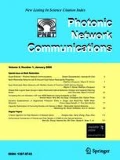Abstract
To fully exploit the upstream bandwidth in Ethernet passive optical networks (EPONs), dynamic bandwidth allocation (DBA) algorithms need to collect the report messages from all the optical network units (ONUs), incurring an idle time comprising the DBA computation time and the round trip time. Some studies have addressed the problem by using the data transmissions of some or all ONUs (ONU-based) to eliminate the idle time. To satisfy the stringent quality of service (QoS) requirements, for example, to improve the packet delay and jitter for delay sensitive applications without degrading QoS support for other types of applications, some studies have proposed to separate the transmission of higher-class and lower-class traffic within one scheduling cycle. Existing studies on the separable scheduling scenario use the class-based concept, that is, use either the higher-class transmission or the lower-class transmission to eliminate the idle time. By contrast, in this paper, an elastic ONU-class-based idle time elimination algorithm (EOCA) is proposed in which the idle time is eliminated using both the higher-class and lower-class transmissions. The proposed mechanism is elastic in the sense that the lower-class transmission is first considered, and then if insufficient lower-class transmissions exist to eliminate the idle time, the OLT pre-allocates the higher-class transmissions in the following cycle to test whether or not the idle time is eliminated. If the idle time is still not eliminated, the OLT reallocates the bandwidth corresponding to the uneliminated idle time to either the last ONU (uneven method) or all of the ONUs (even method) such that the ONU(s) can early transmit any lower-class packets which arrive during the waiting time. Compared to existing class-based or ONU-based idle time elimination algorithms, the proposed EOCA algorithm performs better. The validity of the proposed EOCA algorithm is demonstrated via detailed simulation experiments.


















Similar content being viewed by others
References
Kramer, G, Pesavento, G.: Ethernet passive optical network (EPON): building a next generation optical access network. IEEE Commun. Mag., 40(2), 66–73 (2002)
Kramer, G.: Ethernet Passive Optical Network. McGraw-Hill, NY (2005)
IEEE 802.3ah Task Force Home Page. http://www.ieee802.org/3/efm Accessed Feb. 2012
Kramer, G., Mukherjee, B., Pesavento, G.: Interleaved polling with adaptive cycle time (IPACT): A dynamic bandwidth distribution scheme in an optical access network. Photonic Netw. Commun. 4(1), 89–107 (2002)
Kramer, G., Mukherjee, B., Dixit, S., Ye, Y., Hirth, R.: upporting differentiated classes of service in ethernet passive optical networks. J. Opt. Netw. 1, 280–298 (2002)
Zheng, J., Mouftah, H.T.: Media access control for Ethernet passive optical networks: An overview. IEEE Commun. Mag. 43, 145–150 (2005)
Assi, C.M., Ye, Y., Dixit, S., Ali, M.A.: Dynamic bandwidth allocation for quality-of-service over Ethernet PONs. IEEE J. Sel. Areas Commun. 21, 1467–1477 (2003)
Lee, S., Lee, T.J., Chung, M.Y., Choo, H.: Double-phase polling algorithm based on partitioned ONU-subgroup for high utilization of fiber channel with EPON. In: Telecommunication Networks and Applications Conference, pp. 503–508 (2007)
Choi, S.Y., Lee, S.H., Lee, T.J., Choo, H.: Double-phase polling algorithm based on partitioned ONU subgroups for high utilization in EPONs. IEEE/OSA J. Opt. Commun. Netw. 1(5), 484–497 (2009)
Hwang, I.S., Shyu, Z.D., Ke, L.Y., Chang, C.C.: A novel early DBA mechanism with prediction-based fair excessive bandwidth reallocation scheme in EPON. Comput. Commun. 31(9), 1814–1823 (2008)
Zheng, J.: Efficient bandwidth allocation algorithm for Ethernet passive optical networks. IEE Proc. Commun. 153, 464–468 (2006)
An, F., Hsudh, Y., Kim, K., White, I., Kazovsky, L.: A new dynamic bandwidth allocation protocol with quality of service in ethernet-based passive optical networks. In: Proceedings of International Conference on Wireless and Optical Communication, pp. 165–169 (2003)
Shami, A., Bai, X., Assi, C.M., Ghani, N.: jitter performance in Ethernet passive optical networks. IEEE/OSA J. Lightw. Technol. 23(4), 1745–1753 (2005)
Radivojevic, M.R., Matavulj, P.S.: Implementation of Intra-ONU scheduling for quality of service support in Ethernet passive optical networks. IEEE/OSA J. Lightw. Technol. 27(18), 4055–4062 (2009)
Kim, J.S., Yeon, H.J., Kim, S.G., Lee, J.: HUHG: high utilization and hybrid granting algorithm for EPON. In: International Conference on, Telecommunications, pp. 49 (2006)
Hwang, I.S., Shyu, Z.D., Lee, J.Y.: A QoS-based DBA mechanism in EPON. In: International Conference on the Optical Internet, pp. 14–16 (2008)
Song, H., Kim, B., Mukherjee, B.: Multi-thread polling: A dynamic bandwidth distribution scheme in long-reach PON. IEEE J. Sel. Areas Commun. 27(2), 124–142 (2009)
Jun, Z., Shaoren, Z.: Dynamic bandwidth allocation with high efficiency for EPONs. In: IEEE International Conference on Communications, pp. 2699–2703 (2006)
Hwang, I.S., Shyu, Z.D., Lee, J.Y.: A QoS-enhanced dynamic bandwidth allocation mechanism in EPONs. J. Comput. Inf. Syst. 6(11), 3527–3533 (2010)
Shami, A., Bai, X., Assi, C., Ghani, N.: Jitter performance in Ethernet passive optical networks. IEEE/OSA J. Lightw. Technol. 23(4), 1745–1753 (2005)
Acknowledgments
This work was supported in part by the National Science Council, Taiwan, R.O.C., under Grant NSC 101-2221-E-006-088.
Author information
Authors and Affiliations
Corresponding author
Rights and permissions
About this article
Cite this article
Sue, CC., Lee, TC. Elastic ONU-class-based idle time elimination algorithm for Ethernet passive optical networks. Photon Netw Commun 25, 105–119 (2013). https://doi.org/10.1007/s11107-013-0395-1
Received:
Accepted:
Published:
Issue Date:
DOI: https://doi.org/10.1007/s11107-013-0395-1




